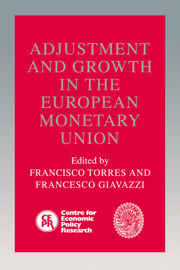Book contents
- Frontmatter
- Contents
- List of figures
- List of tables
- Preface
- List of contributors
- Foreword
- 1 Introduction
- 2 Economic and monetary union: critical notes on the Maastricht Treaty revisions
- Discussion
- 3 The design of optimal fiscal rules for Europe after 1992
- Discussion
- 4 Contracts, credibility and common knowledge: their influence on inflation convergence
- Discussion
- 5 Inflation in fixed exchange regimes: the recent Portuguese experience
- Discussion
- 6 Models of economic integration and localized growth
- Discussion
- 7 Shocking aspects of European monetary integration
- Discussion
- 8 Lessons of Massachusetts for EMU
- Discussion
- 9 Financial and currency integration in the European monetary system: the statistical record
- Discussion
- 10 Currency substitution: from the policy questions to the theory and back
- Discussion
- 11 Coordination of capital income taxes in the economic and monetary union: what needs to be done?
- Discussion
- Index
9 - Financial and currency integration in the European monetary system: the statistical record
Published online by Cambridge University Press: 29 January 2010
- Frontmatter
- Contents
- List of figures
- List of tables
- Preface
- List of contributors
- Foreword
- 1 Introduction
- 2 Economic and monetary union: critical notes on the Maastricht Treaty revisions
- Discussion
- 3 The design of optimal fiscal rules for Europe after 1992
- Discussion
- 4 Contracts, credibility and common knowledge: their influence on inflation convergence
- Discussion
- 5 Inflation in fixed exchange regimes: the recent Portuguese experience
- Discussion
- 6 Models of economic integration and localized growth
- Discussion
- 7 Shocking aspects of European monetary integration
- Discussion
- 8 Lessons of Massachusetts for EMU
- Discussion
- 9 Financial and currency integration in the European monetary system: the statistical record
- Discussion
- 10 Currency substitution: from the policy questions to the theory and back
- Discussion
- 11 Coordination of capital income taxes in the economic and monetary union: what needs to be done?
- Discussion
- Index
Summary
Introduction
The Maastricht Treaty set out convergence of interest rates as one of the key criteria for deciding whether a country in the European Community (EC) can joint the European monetary union (EMU) when it is established in the late 1990s. Specifically, long-term interest rates should be within two percentage points of the average of the three member countries with the lowest rates. There is wisdom in such a test criterion. Politicians occasionally declare their support for regional integration without fully realizing the degree of loss of economic independence that is implied. If a country's interest rate is tied closely to that of its neighbours, it cannot independently use monetary policy to stimulate domestic demand. The criterion of interest rate convergence is a clear test of whether a country is in fact prepared to make the sacrifice of monetary sovereignty that joining EMU will require.
Interest rate convergence comprises two distinct kinds of integration. First, it implies the elimination of capital controls and other barriers to the movement of capital across national boundaries, which we call financial integration or ‘country integration’. Second, it implies the elimination of investor perceptions that the exchange rate is likely to change in the future, which we call ‘currency integration’.
- Type
- Chapter
- Information
- Adjustment and Growth in the European Monetary Union , pp. 270 - 311Publisher: Cambridge University PressPrint publication year: 1993
- 3
- Cited by



